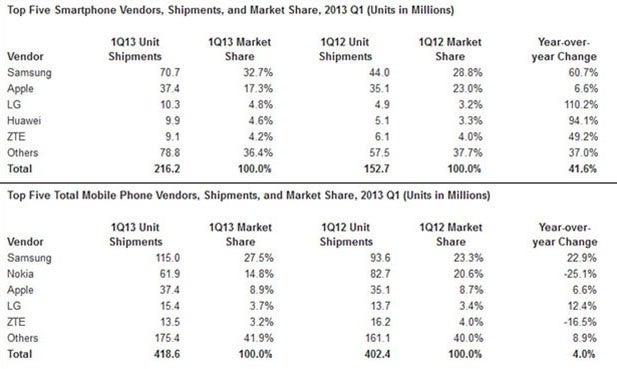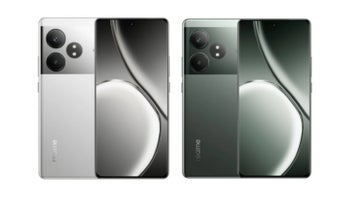RIP, feature phone: smartphones outship dumb handsets in Q1 for the first time

In the worldwide smartphone market, vendors shipped 216.2 million units in 1Q13, which marked the first time more than half (51.6%) the total phone shipments in a quarter were smartphones. The market grew 41.6% compared to the 152.7 million units shipped in 1Q12, but 5.1% lower than the 227.8 million units shipped in 4Q12.
What didn't change, though, is the fact that Apple and Samsung are raking in the vast majority of the profits in the industry, leaving the rest to fight for scraps. Apple is an especially interesting case here, as it keeps riding on the iPhone franchise, making $9.5 billion in the last quarter, with less than 10% of the phone market share, while Samsung made $7.9 billion in operating profit with the largest share of the phone market, which is its bread-and-butter department, too.
More Smartphones Were Shipped in Q1 2013 Than Feature Phones, An Industry First According to IDC
FRAMINGHAM, Mass.--(BUSINESS WIRE)--The worldwide mobile phone market grew 4% year over year in the seasonally slow first quarter of 2013 (1Q13) as smartphones outshipped feature phones for the first time. According to the International Data Corporation (IDC) Worldwide Quarterly Mobile Phone Tracker, vendors shipped a total of 418.6 million mobile phones in 1Q13 compared to 402.4 million units in the first quarter of 2012 and 483.2 million units in the fourth quarter of 2012.
"In addition to smartphones displacing feature phones, the other major trend in the industry is the emergence of Chinese companies among the leading smartphone vendors"
In the worldwide smartphone market, vendors shipped 216.2 million units in 1Q13, which marked the first time more than half (51.6%) the total phone shipments in a quarter were smartphones. The market grew 41.6% compared to the 152.7 million units shipped in 1Q12, but 5.1% lower than the 227.8 million units shipped in 4Q12.
"Phone users want computers in their pockets. The days where phones are used primarily to make phone calls and send text messages are quickly fading away," said Kevin Restivo, senior research analyst with IDC's Worldwide Quarterly Mobile Phone Tracker. "As a result, the balance of smartphone power has shifted to phone makers that are most dependent on smartphones."
"In addition to smartphones displacing feature phones, the other major trend in the industry is the emergence of Chinese companies among the leading smartphone vendors," noted Ramon Llamas, research manager with IDC's Mobile Phone team. "A year ago, it was common to see previous market leaders Nokia, BlackBerry (then Research In Motion), and HTC among the top five. While those companies have been in various stages of transformation since, Chinese vendors, including Huawei and ZTE as well as Coolpad and Lenovo, have made significant strides to capture new users with their respective Android smartphones."
Smartphone Vendor Highlights
Samsung maintained the position it held at the end of 2012: the undisputed leader in the worldwide smartphone market. By the end of 1Q13, Samsung shipped more units than the next four vendors combined. The company revealed its highly anticipated Samsung Galaxy S4 with new features including display, camera, WiFi, and security innovations. What remains to be seen is how Samsung's new Tizen-powered smartphones will look and feel later this year, and fit into the company's overall smartphone portfolio.
Apple's smartphone shipment volume hit a new first-quarter high thanks in part to the iPhone 5, with volume growing 6.6% year over year. However, the last time the iPhone maker posted a single-digit year-over-year growth rate was 3Q09. The iPhone maker has held the second spot in the smartphone rankings for the past five quarters. Apple's mix of models shipped to market is increasingly diversified as it tries to reach new buyers.
LG returned to the smartphone Top 5 after a two-quarter absence, reaching record-high shipments in the process. Its smartphone volume for the quarter was driven in large part by its 3G smartphone portfolio, namely the L series and the Nexus 4. LTE-enabled devices, including the Optimus G series, also contributed to its success. LG hopes to continue its upward trajectory with the launch of the F and L series targeting the mid-range and entry-level segments.
Huawei has shown significant improvement from where it was a year ago, when it offered a handful of Ascend smartphones and had more limited presence outside the Asia/Pacific region. Since then Huawei has decreased its dependence on rebranded feature phones while growing its Ascend portfolio to address multiple customer segments with more branded smartphone offerings. The company nearly doubled its unit shipments to regions outside of Asia/Pacific this past quarter when compared to 1Q12.
ZTE's 1Q13 performance continued the trends established last year, with a strong showing in Asia/Pacific and North America, but a small presence in EMEA and Latin America despite its previous success with low-end feature phones there. With a target of increasing smartphone revenue by 30% this year, ZTE will try to grow in North America and Europe. In China, where increasing price pressure has challenged vendors to grow profitably, ZTE will emphasize its higher-price products. In addition, ZTE will be among the first companies to launch a Firefox-powered smartphone this year.
About IDC Trackers
IDC Tracker products provide accurate and timely market size, vendor share, and forecasts for hundreds of technology markets from more than 100 countries around the globe. Using proprietary tools and research processes, IDC's Trackers are updated on a semiannual, quarterly, and monthly basis. Tracker results are delivered to clients in user-friendly excel deliverables and on-line query tools. The IDC Tracker Charts app allows users to view data charts from the most recent IDC Tracker products on their iPhone and iPad.
For more information about IDC's Worldwide Quarterly Mobile Phone Tracker, please contact Kathy Nagamine at 650-350-6423 or knagamine@idc.com.
About IDC
IDC is the premier global provider of market intelligence, advisory services, and events for the information technology, telecommunications, and consumer technology markets. IDC helps IT professionals, business executives, and the investment community to make fact-based decisions on technology purchases and business strategy. More than 1,000 IDC analysts provide global, regional, and local expertise on technology and industry opportunities and trends in over 110 countries worldwide. For more than 49 years, IDC has provided strategic insights to help our clients achieve their key business objectives. IDC is a subsidiary of IDG, the world's leading technology media, research, and events company. You can learn more about IDC by visiting www.idc.com.
All product and company names may be trademarks or registered trademarks of their respective holders.
FRAMINGHAM, Mass.--(BUSINESS WIRE)--The worldwide mobile phone market grew 4% year over year in the seasonally slow first quarter of 2013 (1Q13) as smartphones outshipped feature phones for the first time. According to the International Data Corporation (IDC) Worldwide Quarterly Mobile Phone Tracker, vendors shipped a total of 418.6 million mobile phones in 1Q13 compared to 402.4 million units in the first quarter of 2012 and 483.2 million units in the fourth quarter of 2012.
"In addition to smartphones displacing feature phones, the other major trend in the industry is the emergence of Chinese companies among the leading smartphone vendors"
In the worldwide smartphone market, vendors shipped 216.2 million units in 1Q13, which marked the first time more than half (51.6%) the total phone shipments in a quarter were smartphones. The market grew 41.6% compared to the 152.7 million units shipped in 1Q12, but 5.1% lower than the 227.8 million units shipped in 4Q12.
"Phone users want computers in their pockets. The days where phones are used primarily to make phone calls and send text messages are quickly fading away," said Kevin Restivo, senior research analyst with IDC's Worldwide Quarterly Mobile Phone Tracker. "As a result, the balance of smartphone power has shifted to phone makers that are most dependent on smartphones."
"In addition to smartphones displacing feature phones, the other major trend in the industry is the emergence of Chinese companies among the leading smartphone vendors," noted Ramon Llamas, research manager with IDC's Mobile Phone team. "A year ago, it was common to see previous market leaders Nokia, BlackBerry (then Research In Motion), and HTC among the top five. While those companies have been in various stages of transformation since, Chinese vendors, including Huawei and ZTE as well as Coolpad and Lenovo, have made significant strides to capture new users with their respective Android smartphones."
Smartphone Vendor Highlights
Samsung maintained the position it held at the end of 2012: the undisputed leader in the worldwide smartphone market. By the end of 1Q13, Samsung shipped more units than the next four vendors combined. The company revealed its highly anticipated Samsung Galaxy S4 with new features including display, camera, WiFi, and security innovations. What remains to be seen is how Samsung's new Tizen-powered smartphones will look and feel later this year, and fit into the company's overall smartphone portfolio.
Apple's smartphone shipment volume hit a new first-quarter high thanks in part to the iPhone 5, with volume growing 6.6% year over year. However, the last time the iPhone maker posted a single-digit year-over-year growth rate was 3Q09. The iPhone maker has held the second spot in the smartphone rankings for the past five quarters. Apple's mix of models shipped to market is increasingly diversified as it tries to reach new buyers.
LG returned to the smartphone Top 5 after a two-quarter absence, reaching record-high shipments in the process. Its smartphone volume for the quarter was driven in large part by its 3G smartphone portfolio, namely the L series and the Nexus 4. LTE-enabled devices, including the Optimus G series, also contributed to its success. LG hopes to continue its upward trajectory with the launch of the F and L series targeting the mid-range and entry-level segments.
Huawei has shown significant improvement from where it was a year ago, when it offered a handful of Ascend smartphones and had more limited presence outside the Asia/Pacific region. Since then Huawei has decreased its dependence on rebranded feature phones while growing its Ascend portfolio to address multiple customer segments with more branded smartphone offerings. The company nearly doubled its unit shipments to regions outside of Asia/Pacific this past quarter when compared to 1Q12.
ZTE's 1Q13 performance continued the trends established last year, with a strong showing in Asia/Pacific and North America, but a small presence in EMEA and Latin America despite its previous success with low-end feature phones there. With a target of increasing smartphone revenue by 30% this year, ZTE will try to grow in North America and Europe. In China, where increasing price pressure has challenged vendors to grow profitably, ZTE will emphasize its higher-price products. In addition, ZTE will be among the first companies to launch a Firefox-powered smartphone this year.
About IDC Trackers
IDC Tracker products provide accurate and timely market size, vendor share, and forecasts for hundreds of technology markets from more than 100 countries around the globe. Using proprietary tools and research processes, IDC's Trackers are updated on a semiannual, quarterly, and monthly basis. Tracker results are delivered to clients in user-friendly excel deliverables and on-line query tools. The IDC Tracker Charts app allows users to view data charts from the most recent IDC Tracker products on their iPhone and iPad.
For more information about IDC's Worldwide Quarterly Mobile Phone Tracker, please contact Kathy Nagamine at 650-350-6423 or knagamine@idc.com.
About IDC
IDC is the premier global provider of market intelligence, advisory services, and events for the information technology, telecommunications, and consumer technology markets. IDC helps IT professionals, business executives, and the investment community to make fact-based decisions on technology purchases and business strategy. More than 1,000 IDC analysts provide global, regional, and local expertise on technology and industry opportunities and trends in over 110 countries worldwide. For more than 49 years, IDC has provided strategic insights to help our clients achieve their key business objectives. IDC is a subsidiary of IDG, the world's leading technology media, research, and events company. You can learn more about IDC by visiting www.idc.com.
All product and company names may be trademarks or registered trademarks of their respective holders.













Things that are NOT allowed: